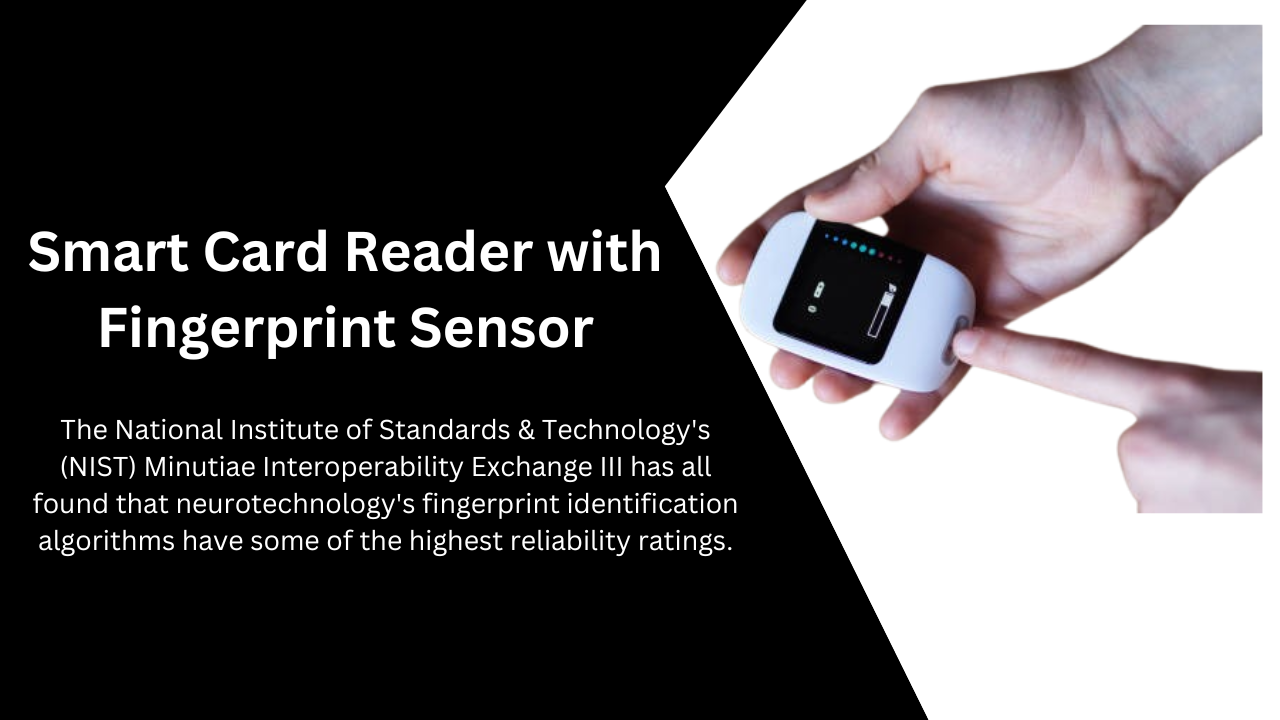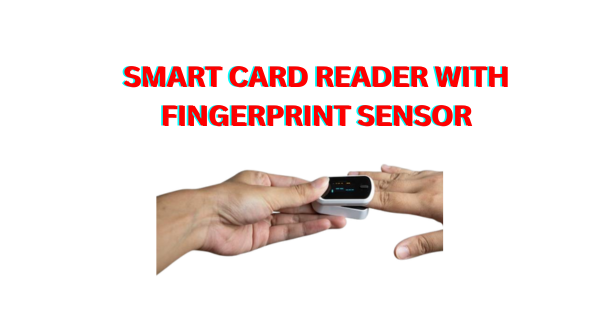Smart Card Reader with Fingerprint Sensor
The Smart Card Reader with Fingerprint Sensor, Fingerprint Supplier Technology Evaluation for the US Department of Justice, the Proprietary Fingerprint Template Evaluation III, and the National Institute of Standards & Technology’s (NIST) Minutiae Interoperability Exchange III have all found that neurotechnology’s fingerprint identification algorithms have some of the highest reliability ratings.
introduction
Based on deep neural networks, the method adheres to the widely recognized fingerprint identification scheme, which makes use of a number of proprietary algorithmic solutions that improve system efficiency and dependability in addition to a set of particular fingerprint points (minutiae). Among them are tiny fingerprint templates, rolled and flat fingerprint matching, and the ability to withstand deformation, rotation, and translation. As the need for secure authentication methods grows, technology has developed to offer ever more complex security solutions. One example of this breakthrough is the fingerprint-sensing smart card reader. This device combines two powerful authentication technologies—smart cards and biometrics—to provide enhanced security, convenience, and efficiency. Based on deep neural networks, the method adheres to the widely recognized fingerprint identification scheme, which makes use of a number of proprietary algorithmic solutions that improve system efficiency and dependability in addition to a set of particular fingerprint points (minutiae).
Awards and evaluations for technology
Since 1998, neurotechnology’s fingerprint identification algorithms have won multiple honors in contests and technology reviews.
What is a smart card reader with a fingerprint sensor?
A smart card reader with a fingerprint sensor is a powerful authentication tool that combines biometric verification and smart card technology. It allows two-factor authentication, which requires users to have a registered fingerprint in addition to a physical smart card in order to be granted access.
Secure data processing and storage are made possible by integrated circuits (ICs) found inSmart Card Reader with Fingerprint Sensor Instead of depending only on passwords or PINs, which are easily hacked, the gadget improves authentication by confirming the user’s distinct biometric characteristics when linked with a fingerprint sensor.
How Does It Operate?
In Smart Card Reader with Fingerprint Sensor, the following procedure is how the fingerprint-sensing smart card reader works:
The smart card is inserted into the reader by the user after it has been chip-enabled.
Fingerprint Scanning: The user’s fingerprint is scanned by the integrated fingerprint sensor.
Data verification and matching:
The smart card’s encrypted biometric information is retrieved by the reader.
It contrasts the recorded information with the scanned fingerprint.
The system allows access if the fingerprints match.
Access Approval: Following verification, the user can move forward with identity verification, access restriction, or secure transactions.
This two-step procedure guarantees that unauthorized people cannot access a smart card without the registered fingerprint, even in the event that it is lost or stolen.
Important Features
Smart card readers with fingerprint sensors are essential for safe authentication since they provide a number of cutting-edge capabilities.
1. Two-Factor Verification
combines your identity (biometric fingerprint) and possession (smart card) to improve security.
2. Strongly Safe Encryption
makes it nearly impossible for hackers to exploit biometric data by processing and storing it in an encrypted format.
3. Fast and Exact Verification
Fast processing speeds, excellent accuracy, and few erroneous rejections are guaranteed by modern fingerprint sensors.
4. Compact and User-Friendly Design
Advantages of Smart Card Reader with a Fingerprint Sensor
1. Improved Protection
removes the possibility of forgotten or stolen passwords.
prevents fraud and illegal access by requiring a distinct fingerprint for verification.
2. Usability and Convenience
You don’t have to remember complicated passwords.
A straightforward fingerprint scan allows users to authenticate fast.
3. Decreased Identity Theft Risk
Fingerprints are distinct and difficult to duplicate.
makes certain that the system is only accessible by authorized users.
4. Quicker Verification Procedure
takes less time to log in than conventional password-based systems.
guarantees seamless and effective user experiences in settings with high security.
5. Economical in the Long Term
reduces the price of lost cards, security breaches, and password resets.
Future Fingerprint-Sensing Smart Card Readers
Secure, quick, and trustworthy authentication techniques are becoming more and more in demand. The following developments will influence smart card readers with fingerprint sensors in the future:
1. AI-Powered Biometric Recognition
The accuracy, mistake rate, and security of fingerprint identification are all being improved by sophisticated AI systems.
2. Biometric Authentication Using the Cloud
In order to facilitate safe fingerprint authentication across numerous devices, future gadgets might incorporate cloud storage.
3. Wireless and Portable Smart Card Readers
Wireless technological advancements will make contactless and portable authentication possible.
4. Authentication via Multi-Biometrics
Future models might use iris scanning or facial recognition for even more robust security.
5. Using Blockchain to Manage Identity
Secure biometric information may be preserved with blockchain technology, guaranteeing permanent identity verification.
Conclusion
To improve convenience, security, and authentication, a smart card reader with a fingerprint sensor is a strong and practical option. The combination of smart card technology and biometric verification offers an unmatched level of security against fraud, identity theft, and unwanted access.
This technology is widely used in the business, government, banking, and healthcare sectors, and as artificial intelligence, cloud authentication, and blockchain security continue to progress, so too will its uses.
It makes sense to invest in a smart card reader with a fingerprint sensor for companies and people looking for a dependable and secure verification method. Securing sensitive data and access privileges in today’s digital environment guarantees a smooth, safe, and effective authentication process.
People also ask
1.How To Use An Android Phone As A Biometric Device
In order to unlock your phone, authenticate payments, and secure apps, you can utilize your phone’s fingerprint scanner for biometric authentication.
2.What are the 7 types of biometrics?
The following biometric recognition criteria are examples of physical identifiers that are related to the composition of the user being validated:
facial recognition.
fingerprints.
The size and placement of fingers is known as hand geometry.
Iris identification.
vein identification.
retinal imaging.
voice recognition.
3.Which fingerprint reader is the best?
best options.
RFID reader M2-EasyScan M2-Fingerprint reader, EasyScan.
HID fingerprint reader, DigitalPersona 4500.
scanner for fingerprints, Mantra MFS 100.
Wireless Fingerprint Scanner FS80H/FS81H.
4.which type of fingerprint sensor is best?
Since ultrasonic fingerprint scanners produce a three-dimensional map of the fingerprint that includes characteristics like blood flow beneath the skin, they are typically regarded as the finest for increased security and accuracy.
5. What is the most popular fingerprint?
loop. The most prevalent kind of fingerprint is the loop. Long loops are formed by the ridges. The ridges on certain people’s fingerprints form a curving S pattern, known as double loops.



